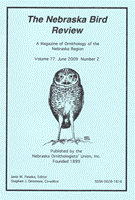Nebraska Ornithologists' Union

Nebraska Bird Review
Date of this Version
3-2016
Document Type
Article
Citation
Silcock, "Winter Field Report, December 2015 to February 2016," from Nebraska Bird Review (March 2016) 84(1).
Abstract
As has been the trend in recent years, many species are lingering later in fall and even arriving earlier in spring. Along with lingering birds, mid-winter and overwintering records have increased. This winter was phenomenal in this respect, especially in that records were across the board in terms of species, suggesting that water conditions have moderated (more open water) and temperatures in general have also (passerines). Unprecedented records included first wintering White-winged Scoter and first Jan or Feb record of Orange-crowned Warbler. Second or third such records were set by Blue-winged Teal, Surf Scoter, Ruddy Duck, Eared Grebe, Greater Yellowlegs, Rock Wren, and Yellow-rumped (Audubon's) Warbler. Late-lingering species were many, highlighted by record late Red-throated Loon, Pied-billed Grebe, and Least Sandpiper. Other noteworthy laggards were Red-necked Grebe, Double-crested Cormorant, Whooping Crane, Ruby-crowned Kinglet, Hermit Thrush, Rose-breasted Grosbeak, Savannah Sparrow, Lincoln's Sparrow, and Dickcissel, while Eastern Bluebirds set a new CBC high and Yellow-rumped Warblers were present through winter in almost unprecedented numbers (see last winter). Early spring arrivals are usually determined by factors other than local Nebraska environmental conditions, and so are perhaps less variable; nevertheless there were early-arriving Turkey Vulture, American Woodcock, and Franklin's Gull.
Perhaps the presence of these numerous winter phenomena allowed other species to winter farther north; there were no Herring Gulls reported 6-27 Jan, only 3 Red Crossbill reports were received, at least one of those of Pacific Coast Type 3 birds, and very few Townsend's Solitaires were counted. Perhaps the only species that was unexpectedly low in numbers given these occurrences was Red-headed Woodpecker, virtually absent from the state, even at its winter stronghold, Indian Cave State Park. Additional significant numbers were a report of 10,000 American Robins, large numbers of Pine Siskins and American Goldfinches, and good numbers again of Yellow-bellied Sapsuckers.
Interesting observations included an apparent shift eastward of wintering Brown Creepers, the still-parlous state of Black-billed Magpie in the state, now only in fair numbers in Keith and Scotts Bluff Cos. Eurasian Collared-Doves are abundant in the west, but in the east numbers are far lower, albeit increasing slowly. The third record of Barred Owl in Lincoln Co was of one in a large parking lot in North Platte; it was surmised that all three may have been hit by semis on 1-80 and transported there.
As well as all of the winter excitement, there were several rarities detected, including one first state record. Unfortunately, it was Mute Swan, finally added to the state list based on numerous reports that have been difficult to pass off as escapees or released birds. In addition, Nebraska's 7th Black-throated Sparrow appeared at the feeders of the Records Committee Chairman (I think it will be accepted), and there were rare sightings of Barrow's Goldeneye in the east, near adult Kumlien's Gull, Gyrfalcon, Common Raven (they like Applebee's and Burger King), Varied Thrush, and Pine Grosbeak.


Comments
Copyright 2016 Nebraska Ornithologists’ Union. Used by permission.